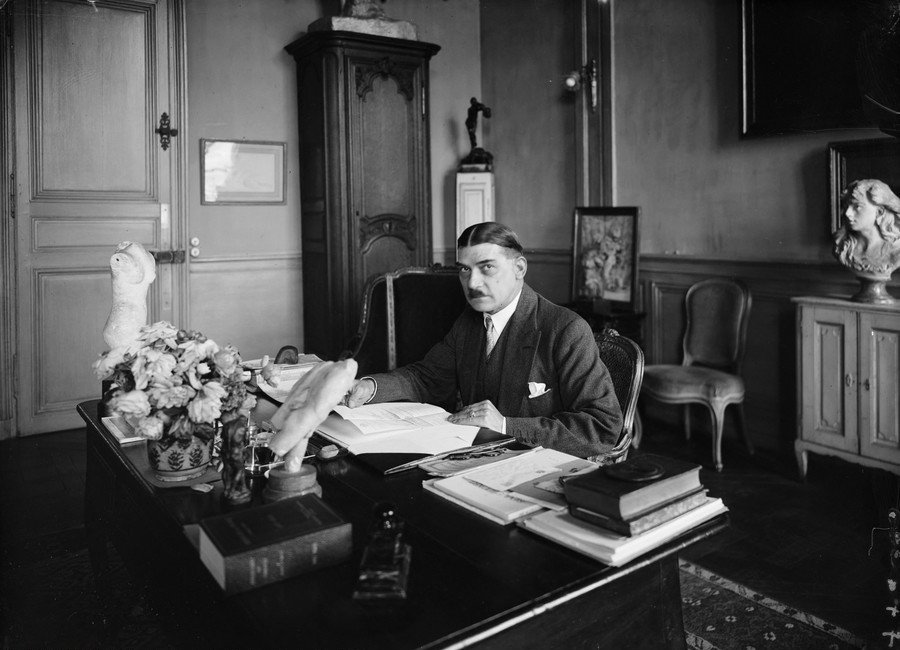
GRAPPE Georges (EN)
Georges Grappe was a man of letters engaged in l’Action Française. He became curator of the Rodin museum in 1925 and during World War II was heavily involved in collaboration.
A man of letters involved in l’Action Française
Georges Pierre François Grappe was born in Paris 13 July 1879 in the 2nd arrondissement. He did his secondary school studies at lycée Henri-1V, where he became friends with Jacques Bainville. From 1897-1898, he followed the course of Salomon Reinach (national archeology) and of André Michel (sculpture of the Middle Ages, the Renaissance and Modern Times) at the École du Louvre.1 He spent some time in England at Oxford. Although before 1900 his ideas were socially Catholic and rather liberal, at the turn of the century, his political positions became very much influenced by Barrès and Maurras and were explicit: “The traditionalist royalist spirit, the ideal of Maurras, had placed its best hopes in M. Georges Grappe…".2 He frequented the Barrès acolyte Pierre Adam and became particularly sociable; he took on the ideas of L’Action Française,3 a newspaper he wrote articles for, as well as for L’Opinion, for Jean Richepin, president of the editorial committee.
Grappe became a man of letters as of 1899 and, until the end of his life, published numerous literary and artistic studies.4 In 1911 he received the Langlois prize of the Académie française for his translation of Barrett Wendell, La France d’aujourd’hui. His best known work, H. Fragonard : peintre de l’amour au XVIIIe siècle, was published in 1913. He was also an art critic and taught at the École pratique de hautes études and at the Collège libre des sciences sociales.5 He was mobilized in 1914 and in 1917 assigned to the staff of general Pétain, in charge of information with the 2nd army. He was awarded the Croix de Guerre and was promoted chevalier de la Légion d’honneur in 1924; in 1939 he was an officer, as a man of letters.6 In 1917 he married Léonie Corbières, a singer.
After 1918 Grappe became interested in the living conditions of the man of letters. Until the end of 1926 he was secretary of the Société du droit d’auteur aux artistes (Société for royalties to artists), founded in 1910 and directed by Georges Delavenne. The aim of the society, of which Rodin was a member, was to defend the rights of artists and, as of 1920, resales rights.7 As secretary, he was able to enter into relation with the Rodin museum when dealing with certain files. On 29 July 19258 he was named curator of the Rodin museum, following Léonce Bénédite, who had died a few months earlier.9 In 1930, Georges Grappe claimed to be a friend of Chiappe, Chief of Police.10 In 1934, the sculptor Charles Despiau was elected member of the administrative board of the Rodin museum.11
Grappe then became more discreet about his opinions. However, in 1919, when nationalist intellectuals were condemned in manifestos by a group from the review Clarté (signed by Romain Rolland, Henri Barbusse and endorsed by Anatole France), George Grappe joined with those who signed the manifesto in answer to them: “For an intelligence party,” published in the supplement of the 19 July 1919 Figaro, signed by artists, by Maurras, and also, when published in L’Action française, other signatures of Maurrasians, of traditional Catholics, avid supporters of a classical esthetic, and antidemocratic activists. George Grappe stated: “Our generation owes everything to Barrès.”12 He became a member of the Société des gens de lettres in 1932, continued to collaborate with L’Opinion, was mentioned and often published in the review Comœdia.13 He obviously maintained his pre-war friendships.
A collaborationist curator at the Rodin museum
During the Second World War, Georges Grappe remained close to Philippe Pétain. He was separated from his wife since 1940 and lived at 104 rue du Bac with Mlle Hilbert, secretary at the Rodin museum. Beginning in September 1939, he organized the sheltering of the museum’s collections (with the exception of bronzes, drawings and the paintings collection) in various châteaux of the Loir-et-Cher and the Loiret.1 When the Rodin museum re-opened in July 1940, Grappe organized the exhibit “Centenaire Monet-Rodin au profit de l’Entr’aide des artistes.” (Monet-Rodin centenary for the benefit of artists’ Mutual aid) in the Orangerie museum from 7 December 1940 to 16 March 1941.2 It was the first exhibit since the armistice and was inaugurated in the presence of Louis Hautecœur, Jacques Jaujard, Fernand de Brinon and Otto Abetz. The majority of Rodin’s works came from the museum, with the exception of two loaned by Eugène Rudier.
Grappe was part of the Collaboration group, unofficially founded by the writer Alphonse de Chateaubriant in the Fall of 1940 and authorized in February 1941.3 At the request of Max d’Ollone, he became president of the Arts plastiques section, assisted by Othon Friesz and Paul Belmondo. The group’s aim was a French-German rapprochement. It published in La Gerbe and on 22 May 1942 organized a reception in the Rodin museum in honor of Arno Breker, to celebrate the inauguration of his exhibition in the Orangerie museum. The sculptor was welcomed “in brotherly fashion” by the members of the Arts plastiques section of the Collaboration group. In his address, Abel Bonnard, education minister of the Vichy government, noted: “…the German armies that form in the East the colossal barrier and alone preserve Europe from a flood of shadows… .” In addition, Grappe had frequent contacts with members of the “Kunstschutz” section (Committee for the protection of the artistic heritage) in Paris, headed by count Franz von Wolff-Metternich: Hermann Bunjes, Hans Möbius, Carlheinz Pfitzner were frequent guests at his home rue du Bac. For George Grappe, the period of the Occupation was the apogee of his career as an art historian.4
The two large orders of bronzes from the philanthropists Kojiro Matsukata and Jules Mastbaum had made it possible in the 1920s to ensure the financial autonomy of the Rodin museum as a public establishment.5 A large part of this financial input contributed to creating the museum’s portfolio; furthermore, thanks to this intake, the administrative board decided to build up a stock of original bronzes (known as “plastic reproductions”) designed to be sold, with royalties for the Rodin museum. Thus, about sixty castings were chosen. The order was decided upon by the administrative board during the 18 November 1926 session and taken in charge beginning in January 1927 by Eugène Rudier, official founder of Rodin’s works.6 It was thought at the time that over the years these proofs would be sold, but the 1929 market crisis had repercussions on sales – there were hardly any in the following years, and a large stock remained when World War II broke out.7
Grappe’s friendships dating from his early years and Rudier’s ambiguous relationships – his closeness, in particular, to the sculptor Arno Breker – put the Rodin museum in a situation of subjection to the occupant.8 It was thus that the museum, directly or through the intermediary of Rudier, sold a good part of its stock. In fact, the 1934 inventory9 recorded 172 bronzes (among them two terracottas, one wax and seven glass pastes from the Rodin stock, and some doubled – a, b, some even tripled c numbers). From June 1935 to June 1940 fifteen castings and two plasters were added to the stock, bringing the number of “plastic reproductions” to 189. From June 1940 to the end of 1944, 127 numbers, of which two plasters, were added to the inventory (some numbers were cast after the month of August) – note that one single number represents a group of ten small hands (number 185, 1-10). At the Liberation, two-thirds of the stock’s bronzes had been sold, the sales prices calculated according to the initial price of cast-iron of each bronze, that of the late 1920s, for castings in the 1934 to June 1940 inventory. In other words, they were sold at the price of cast iron in the 1940s for pieces executed during the Occupation.10
Buyers were mainly German museums (Städtische Galerie in Francfort-sur-le-Main, Wallraf-Richartz museum in Cologne, Düsseldorf museum, Landesgalerie in Salzburg, Linz museum in Austria, etc), senior officials or art market entities (Fritz Todt, Hildebrandt Gurlitt, galerie Ernst Arnold (or Gutbier) in Munich, galerie Friedrich Welz in Salzburg, etc), but also Sacha Guitry, Hoffmann Oberlit de Bruxelles, professor Richard Bieling in Marburg, Stockert in Nancy, M. Danthon, the gallery owner André Schoeller, M. Kauffmann in Leipzig, M. Hessa, M. Goertz, etc., and above all Rudier in the role of intermediary. The most important examples of sales in 1942 (after the Breker exhibit) are those of the Porte de l’Enfer, ordered by Arno Breker for the Linz museum (in the end acquired by the museum of Zurich), the sale of the monument of the Bourgeois de Calais to the Wallraf-Richartz museum in Cologne, and the Baiser monumental for the Ernst Arnold museum in Munich, 18 November 1942.11 In order to sell certain castings to the occupant rapidly, the museum did not hesitate to transfer certain works in the collections onto the inventory of commercial bronzes (Le Désespoir, n° 181, L’Enfant prodigue, n° 183), without waiting for a commercial casting to be done.12 The Rodin museum became a national museum on 27 October 1943.
Grappe was suspended from his functions at the Liberation, as of 7 September 1944; he was arrested, interned, and officially removed from office without a pension on 12 March 1945.13 In the Fall of 1944, he was replaced by Marcel Aubert, head curator of the Sculpture department of the Louvre museum. Georges Grappe died on 26 April 1947.
Grappe’s collaboration with the occupant was clear, and corresponded to his established positions and those of his longtime friends. He was a supporter of Pétain and accepted the German occupation. He dragged the Rodin museum into this subjection, selling to the Germans at very low prices commercial bronzes, as well as drawings, and organizing a reception in honor of Arno Breker, with a manifest show goodwill. Was it a matter of sympathy or simple acquiescence? His links with the bosses of the “Kunstschutz” – count Franz von Wolff-Metternich, Hermann Bunjes, Hans Möbius, Carlheinz Pfitzner – accentuate that ambiguity.
Basic data
Personne / personne



